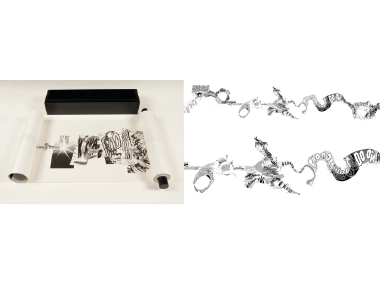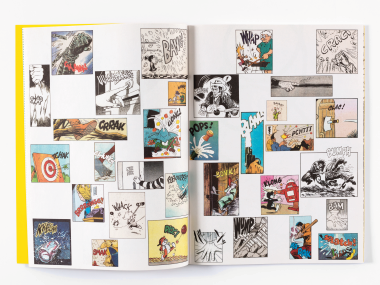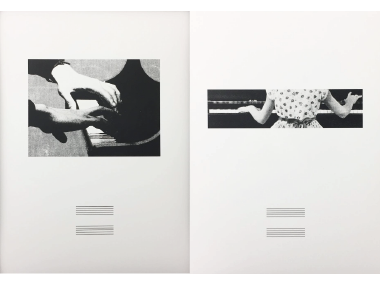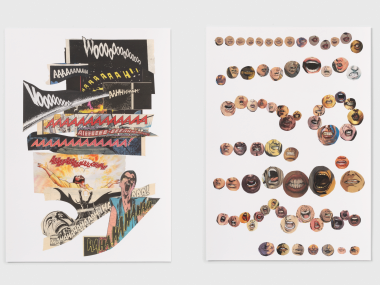 Christian Marclay. Graffiti Composition, 1996-2002
Christian Marclay. Graffiti Composition, 1996-2002
Graffiti Composition, 1996-2002 In 1996, during a month-long music festival, Marclay placed five thousand posters with staff lines all over Berlin for people to modify. Some would tear or scribble drawings, while others would attach flyers, and many left musical notations. Subsequently, the altered posters were photographed, resulting in a final score consisting of an unbound portfolio of 150 images. Musicians are free to select any number of them and use them in performances or as inspiration for composing their own music.
 Christian Marclay. Shuffle, 2007
Christian Marclay. Shuffle, 2007
Shuffle, 2007
These photographs of musical notations found in mundane settings, such as awnings, chocolate tins, and t-shirts, are evidence of Marclay's keen eye for spotting musical notes waiting to be discovered and played. The box contains these artist's instructions: "This deck of cards can be used as a musical score. Shuffle the deck and draw your cards. Create a sequence using as many or as few cards as you like. Play solo or with others. Invent your own rules. Sounds can be generated or simply imagined.
 Christian Marclay. Manga Scroll, 2010
Christian Marclay. Manga Scroll, 2010
Manga Scroll, 2010 This vocal score consists of onomatopoeias found in Manga comic series originally published in Japan but translated for the U.S. market. These black-and-white newsprint comics have been cut and assembled to create a collage on a sixty-foot-long scroll. This type of scroll, which was invented in the 11th century, is considered the precursor to contemporary Japanese graphic novels. Stripped of their dramatic context, the sound effects are combined into a lengthy composition intended to be performed vocally.
 Christian Marclay. To Be Continued, 2016
Christian Marclay. To Be Continued, 2016
To Be Continued, 2016 Created in 2016, To Be Continued is a musical score for guitar, wind instruments, double bass, and percussion. It was crafted to serve as a musical score for the ensemble baBel, with whom Marclay has closely collaborated since 2012.
 Christian Marclay. Ephemera, 2009
Christian Marclay. Ephemera, 2009
Ephemera, 2009 Fragments from Marclay's eclectic collection of newspaper advertisements, magazine illustrations, restaurant menus, candy wrappers, and other disposable printed materials adorned with musical notations were photographed and reproduced in twenty-eight unbound offset lithographs. These images form a score that can be arranged and performed using one or more instruments.
 Christian Marclay. Investigations, 2018
Christian Marclay. Investigations, 2018
Investigations, 2018 This box contains one hundred photographs intended to generate music for a large ensemble of pianos. Before the concert, each pianist receives a box and must decipher each image, looking for clues that indicate what sounds may have been heard just before, during, or just after the movement was captured by the camera. The findings of their investigation should then be noted beneath the images without sharing them with other musicians. Before the performance begins, each box of photographs must be shuffled. The musicians perform independently of each other at their own pace, with the freedom to take silent pauses as they prepare for the next action. They should recreate the physical posture as well as the use of pedals when visible in the photograph. When more than two hands are required, the pianist silently seeks assistance from other performers.
 Christian Marclay. No!, 2020
Christian Marclay. No!, 2020
No!, 2020
No! is a portfolio of 15 prints created from collages using fragments of comics. In contrast to "Manga Scroll" (2010), which is a composition consisting of onomatopoeias disconnected from their generative actions, this work reveals more of the context from which these fragments were sampled, encouraging the vocalist to physically express the emotion and illustrated movements.
 Christian Marclay. The Bell and the Glass, 2003
Christian Marclay. The Bell and the Glass, 2003
The Bell and the Glass, 2003 This work, Marclay's first attempt to guide musicians through the use of moving images, is what he calls a "video score." It was inspired by two of Philadelphia's most famous icons: the Liberty Bell and Marcel Duchamp's "The Bride Stripped Bare by Her Bachelors, Even (The Large Glass)" (1915-23). Apart from being cracked and situated in Philadelphia, Marclay found other surprising and often amusing affinities between the two objects. The dual video projection juxtaposes the Liberty Bell and The Large Glass with fragments of found footage, such as Duchamp discussing the cracks in his work, clips from Hollywood movies, and new footage shot by Marclay in Philadelphia. To activate this score, a minimum of two musicians is required to freely respond to the two screens, but they must come together in unison to accompany Duchamp's voice, which has been transcribed into three accompanying scores. This video was commissioned by the Philadelphia Museum of Art and the ensemble Relâche.
 Christian Marclay. Screen Play, 2005
Christian Marclay. Screen Play, 2005
Screen Play, 2005 This projected musical score is created through careful editing of black-and-white images overlaid with brightly colored computer-generated graphics reminiscent of the dots and lines of traditional musical notation. These visual cues suggest emotion, energy, rhythm, pitch, volume, and duration to the musicians. While no specific instrumentation is specified, the score is intended for a small ensemble. This video was made possible with the support of Eyebeam's Moving Image Commission.
 Christian Marclay. Zoom zoom, 2007-on going
Christian Marclay. Zoom zoom, 2007-on going
Zoom Zoom, 2007-2022 This work is a slide presentation created from Marclay's photographs of onomatopoeias found primarily on posters, advertisements, and product packaging. During a performance with vocalist Shelley Hirsch, for whom he created this piece, Marclay selects images to trigger her vocal improvisation, presenting her with new images in an ongoing call-and-response.